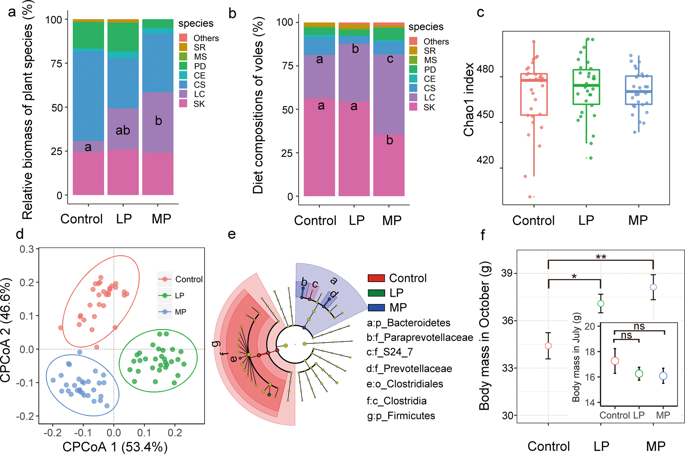Our official English website, www.x-mol.net, welcomes your feedback! (Note: you will need to create a separate account there.)
Host-microbiota interaction helps to explain the bottom-up effects of climate change on a small rodent species.
The ISME Journal ( IF 11.0 ) Pub Date : 2020-04-20 , DOI: 10.1038/s41396-020-0646-y Guoliang Li 1, 2 , Baofa Yin 3 , Jing Li 4 , Jun Wang 4 , Wanhong Wei 3 , Daniel I Bolnick 5 , Xinrong Wan 1 , Baoli Zhu 4 , Zhibin Zhang 1, 2
The ISME Journal ( IF 11.0 ) Pub Date : 2020-04-20 , DOI: 10.1038/s41396-020-0646-y Guoliang Li 1, 2 , Baofa Yin 3 , Jing Li 4 , Jun Wang 4 , Wanhong Wei 3 , Daniel I Bolnick 5 , Xinrong Wan 1 , Baoli Zhu 4 , Zhibin Zhang 1, 2
Affiliation

|
The population cycles of small rodents have puzzled biologists for centuries. There is a growing recognition of the cascading effects of climate change on the population dynamics of rodents. However, the ultimate cause for the bottom-up effects of precipitation is poorly understood, from a microbial perspective. Here, we conducted a precipitation manipulation experiment in the field, and three feeding trials with controlled diets in the laboratory. We found precipitation supplementation facilitated the recovery of a perennial rhizomatous grass (Leymus chinensis) species, which altered the diet composition and increase the intake of fructose and fructooligosaccharides for Brandt's vole. Lab results showed that this nutrient shift was accompanied by the modulation of gut microbiota composition and functional pathways (especially for the degradation or biosynthesis of L-histidine). Particularly, the relative abundance of Eubacterium hallii was consistently increased after feeding voles with more L. chinensis, fructose or fructooligosaccharide. These modulations ultimately increased the production of short chain fatty acids (SCFAs) and boosted the growth of vole. This study provides evidence that the precipitation pulses cascades through the plant community to affect rodent gut microbiome. Our results highlight the importance of considering host-microbiota interaction when investigating rodent population responses to climate change.
中文翻译:

宿主-微生物群相互作用有助于解释气候变化对小型啮齿动物物种的自下而上影响。
几个世纪以来,小型啮齿动物的种群周期一直困扰着生物学家。人们越来越认识到气候变化对啮齿动物种群动态的级联影响。然而,从微生物的角度来看,对降水自下而上效应的最终原因知之甚少。在这里,我们在野外进行了一项降水控制实验,并在实验室进行了三项控制饮食的喂养试验。我们发现补充降水促进了多年生根茎草 (Leymus chinensis) 物种的恢复,这改变了布兰特田鼠的饮食组成并增加了果糖和低聚果糖的摄入量。实验室结果表明,这种营养转变伴随着肠道微生物群组成和功能途径的调节(尤其是 L-组氨酸的降解或生物合成)。特别是,在给田鼠喂食更多的 L. chinensis、果糖或低聚果糖后,Halli 真杆菌的相对丰度持续增加。这些调节最终增加了短链脂肪酸 (SCFA) 的产量并促进了田鼠的生长。这项研究提供了证据,表明降水脉冲通过植物群落级联影响啮齿动物肠道微生物组。我们的结果强调了在调查啮齿动物种群对气候变化的反应时考虑宿主-微生物群相互作用的重要性。给田鼠喂食更多的 L. chinensis、果糖或低聚果糖后,Halii 真杆菌的相对丰度持续增加。这些调节最终增加了短链脂肪酸 (SCFA) 的产量并促进了田鼠的生长。这项研究提供了证据,表明降水脉冲通过植物群落级联影响啮齿动物肠道微生物组。我们的结果强调了在调查啮齿动物种群对气候变化的反应时考虑宿主-微生物群相互作用的重要性。给田鼠喂食更多的 L. chinensis、果糖或低聚果糖后,Halii 真杆菌的相对丰度持续增加。这些调节最终增加了短链脂肪酸 (SCFA) 的产量并促进了田鼠的生长。这项研究提供了证据,表明降水脉冲通过植物群落级联影响啮齿动物肠道微生物组。我们的结果强调了在调查啮齿动物种群对气候变化的反应时考虑宿主-微生物群相互作用的重要性。这项研究提供了证据,表明降水脉冲通过植物群落级联影响啮齿动物肠道微生物组。我们的结果强调了在调查啮齿动物种群对气候变化的反应时考虑宿主-微生物群相互作用的重要性。这项研究提供了证据,表明降水脉冲通过植物群落级联影响啮齿动物肠道微生物组。我们的结果强调了在调查啮齿动物种群对气候变化的反应时考虑宿主-微生物群相互作用的重要性。
更新日期:2020-04-24
中文翻译:

宿主-微生物群相互作用有助于解释气候变化对小型啮齿动物物种的自下而上影响。
几个世纪以来,小型啮齿动物的种群周期一直困扰着生物学家。人们越来越认识到气候变化对啮齿动物种群动态的级联影响。然而,从微生物的角度来看,对降水自下而上效应的最终原因知之甚少。在这里,我们在野外进行了一项降水控制实验,并在实验室进行了三项控制饮食的喂养试验。我们发现补充降水促进了多年生根茎草 (Leymus chinensis) 物种的恢复,这改变了布兰特田鼠的饮食组成并增加了果糖和低聚果糖的摄入量。实验室结果表明,这种营养转变伴随着肠道微生物群组成和功能途径的调节(尤其是 L-组氨酸的降解或生物合成)。特别是,在给田鼠喂食更多的 L. chinensis、果糖或低聚果糖后,Halli 真杆菌的相对丰度持续增加。这些调节最终增加了短链脂肪酸 (SCFA) 的产量并促进了田鼠的生长。这项研究提供了证据,表明降水脉冲通过植物群落级联影响啮齿动物肠道微生物组。我们的结果强调了在调查啮齿动物种群对气候变化的反应时考虑宿主-微生物群相互作用的重要性。给田鼠喂食更多的 L. chinensis、果糖或低聚果糖后,Halii 真杆菌的相对丰度持续增加。这些调节最终增加了短链脂肪酸 (SCFA) 的产量并促进了田鼠的生长。这项研究提供了证据,表明降水脉冲通过植物群落级联影响啮齿动物肠道微生物组。我们的结果强调了在调查啮齿动物种群对气候变化的反应时考虑宿主-微生物群相互作用的重要性。给田鼠喂食更多的 L. chinensis、果糖或低聚果糖后,Halii 真杆菌的相对丰度持续增加。这些调节最终增加了短链脂肪酸 (SCFA) 的产量并促进了田鼠的生长。这项研究提供了证据,表明降水脉冲通过植物群落级联影响啮齿动物肠道微生物组。我们的结果强调了在调查啮齿动物种群对气候变化的反应时考虑宿主-微生物群相互作用的重要性。这项研究提供了证据,表明降水脉冲通过植物群落级联影响啮齿动物肠道微生物组。我们的结果强调了在调查啮齿动物种群对气候变化的反应时考虑宿主-微生物群相互作用的重要性。这项研究提供了证据,表明降水脉冲通过植物群落级联影响啮齿动物肠道微生物组。我们的结果强调了在调查啮齿动物种群对气候变化的反应时考虑宿主-微生物群相互作用的重要性。



























 京公网安备 11010802027423号
京公网安备 11010802027423号